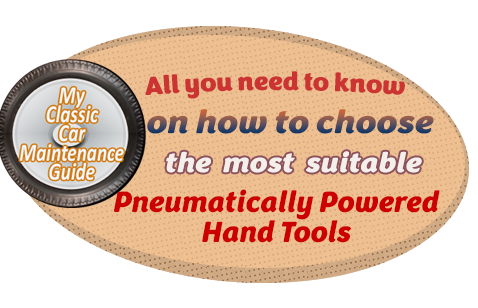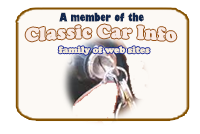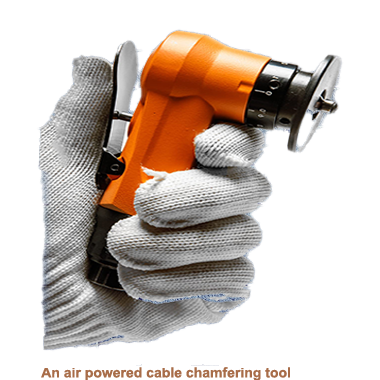
Pneumatically powered tools, operated using compressed air, have played a fundamental part in professional car maintenance and repair workshops for more than half a century.
Largely phased out by the widespread use of electrically powered tools and latterly battery-operated cordless systems, in their time air tools were regarded as the benchmark for efficiency and power.
 Pneumatically powered tools still retain their place in maintenance and repair workshops in situations where power, speed, torque, and durability are essential requirements for powering ratchets, impact wrenches sanders, paint sprayers, and grinders.
Pneumatically powered tools still retain their place in maintenance and repair workshops in situations where power, speed, torque, and durability are essential requirements for powering ratchets, impact wrenches sanders, paint sprayers, and grinders.
 The benefits of pneumatically powered tools are many with one being that they are usually lighter in weight than electric or battery-powered options as they do not require the heavy motors or batteries found in those devices to power them.
The benefits of pneumatically powered tools are many with one being that they are usually lighter in weight than electric or battery-powered options as they do not require the heavy motors or batteries found in those devices to power them.
This factor goes a long way to reducing fatigue build up, especially during extended working sessions. Even though pneumatically powered tools are lightweight, they are capable of providing remarkable torque and cutting capability, making them particularly effective for tasks such as removing rusted bolts, grinding welds, or sanding panels.
Internal mechanisms in pneumatic tools are simpler than those found in electric or battery-operated tools. The absence of complex motors or delicate electronics means that these tools typically experience reduced wear and tear.All that is required is consistent lubrication and maintenance to ensure that pneumatically powered tools will remain in service e for many years, even with continuous use in bustling workshops.
A single compressor has the capability to power multiple tools, simultaneously providing levels of flexibility, eliminating the necessity for individual motors in each device. Because they do not require electricity to operate pneumatically powered tools are safer in settings where potentially dangerous dust or fumes are generated, a important vital factor in specific aspects of automotive bodywork. It goes without saying that a compressor, it’s attendant air hoses and fittings, air tools cannot operate. This means that workshops who do not have a compressed air system in place will require a considerable investment to set up a system.
It goes without saying that a compressor, it’s attendant air hoses and fittings, air tools cannot operate. This means that workshops who do not have a compressed air system in place will require a considerable investment to set up a system.Pneumatic tools are connected from the compressor by air hoses, These hoses limit mobility and present trip hazards on the workplace floor.
 In addition, pneumatic tools and air compressors generate much higher noise levels louder than their corded or battery-operated counterparts especially when operating grinders, and sanders. Long-term exposure to noise without the right ear protection has been known to cause increased workshop fatigue.
and in certain cases, partial hearing loss.
Moisture buildup generated by compressed air systems will eventually cause harm to instruments and could jeopardise processes such as spray painting if it is not adequately filtered.
In addition, pneumatic tools and air compressors generate much higher noise levels louder than their corded or battery-operated counterparts especially when operating grinders, and sanders. Long-term exposure to noise without the right ear protection has been known to cause increased workshop fatigue.
and in certain cases, partial hearing loss.
Moisture buildup generated by compressed air systems will eventually cause harm to instruments and could jeopardise processes such as spray painting if it is not adequately filtered.
This will require investment in auxiliary devices, such as dryers and filters, needed to maintain clean, dry air.
An air compressor requires a large amount of electricity to operate; energy expenses are likewise greater. This will eventually reduce their cost-effectiveness, when compared to contemporary cordless alternatives. These factors combined with advances on lithium-ion battery technology progresses have meant that compressed-air systems are rapidly becoming less common in many workshops. In a very large number of applications, even cordless tools are capable of matching pneumatic tools in torque and speed while requiring a much smaller setup investment, meaning that workshops that make significant investments in air tools are becoming few and far between. Despite their drawbacks, pneumatic tools can still be found in daily use in vehicle maintenance and repair shops especially for heavy-duty, high-frequency tasks where reliability and raw power are crucial.
Despite their drawbacks, pneumatic tools can still be found in daily use in vehicle maintenance and repair shops especially for heavy-duty, high-frequency tasks where reliability and raw power are crucial.
Stray painting still lends itself to air-powered spray guns because compressed air offers the highest levels of even and smooth application needed for expert finishes.
 However, the disadvantages of compressors, hoses, and noise frequently exceed the advantages for mobile mechanics, freelance restorers, and smaller businesses. In certain situations, a combination of corded tools for prolonged work and battery-operated tools for mobility may provide a more useful and cost-effective option.
With the advancement of technology, numerous workshops are transitioning to cordless and electric options. For individuals who prioritise consistency, durability, and proven performance, pneumatic tools continue to be a valuable asset. Recognising their strengths, planning for their weaknesses, and integrating them into a balanced toolkit that combines the best of traditional and modern power systems is essential.
However, the disadvantages of compressors, hoses, and noise frequently exceed the advantages for mobile mechanics, freelance restorers, and smaller businesses. In certain situations, a combination of corded tools for prolonged work and battery-operated tools for mobility may provide a more useful and cost-effective option.
With the advancement of technology, numerous workshops are transitioning to cordless and electric options. For individuals who prioritise consistency, durability, and proven performance, pneumatic tools continue to be a valuable asset. Recognising their strengths, planning for their weaknesses, and integrating them into a balanced toolkit that combines the best of traditional and modern power systems is essential.